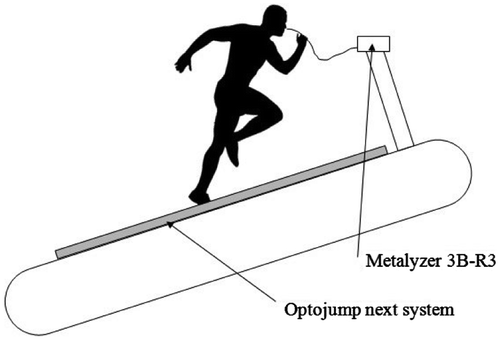1. Introduction
There are two distinctive patterns of human locomotion: walking and running. When increasing the speed of locomotion, a spontaneous transition occurs (walk-to-run) at approximately 2 m.s−1. This intensity is commonly referred to as the preferred transition speed (PTS) (Hreljac Citation1993; Prilutsky & Gregor Citation2001). To date, various mechanisms has been investigate to trigger the transition in human gait from walking to running. (Hreljac Citation1993; Hreljac Citation1995; Kram et al. Citation1997; Prilutsky & Gregor Citation2001; Hug et al. Citation2003; Sentija & Markovic Citation2009). We can observe that hypotheses are very heterogeneous such a metabolic, kinetic, kinematic, neuromuscular or anthropometric factors. Interestingly, some authors link PTS with cardio-respiratory variables as aerobic (VT1) and anaerobic (VT2) thresholds (Sentija & Markovic Citation2009) and found a correlation between VT1 and PTS on flat.
Mountain running races are very popular and number of patricians increased importantly during last decade. Due to natural field topography and slope associated, runners alternate walking and running phases. To our knowledge, there is no evidence in literature of potential mechanism responsible to PTS when locomotion is performing with slope. The aim of the present study was to investigate relationship between PTS and cardio-respiratory parameters as VT1 or VT2 during an incremental test in a gradient slope.
2. Methods
2.1 Subject
18 male mountain runners (30.2 ± 8.2 yrs; 1.79 ± 0.06 m; 69.1 ± 6.7 kg) participated to this study. All participants were free of injury and provide their consent in accordance with the international ethical standards described by the Declaration of Helsinki.
2.2 Experimental design
All subjects performed specific incremental tests based on ascending speed on a large motorised treadmill (S 1930, HEF Techmachine, Andrezieux-Boutheon, France) with 25% slope. Begining of the test was set at 500 m/h (meters/hour) and increase by 100 m/h every minute until subject can’t maintain the intensity.
2.3 Measurements
During the test, several walking and running parameters were collected with 3 meters of Optojump Next system (Microgate, Bolzano, Italy) placed each side of the running belt Figure . This configuration permitted to obtain step cadence (CAD in Hz), contact time on the belt (Tc in ms) and confirm the transmission from walking to running when double feet support disappears.
In addition, metabolic measurement was performed during 2 minutes at rest and during entire incremental test. Breath-by-breath gaz exchanges were measured by Metalyzer 3B-R3 system (Cortex, Leipzig, Germany). Breathing flow were measured trough bi-directional digital turbine and 220-cm sample line tube collected inspired and expired air to measure O2 and CO2 concentrations. All data were transmitted wirelessly to computer using MetaSoft© studio software in order to calculated O2 consumption (VO2, L.min−1) and CO2 output (VCO2, L.min−1). VT1 and VT2 were determined based on Beaver methods (Beaver et al. Citation1986) by experimented operator.
2.4 Statistical analysis
Results are presented as mean ± standard deviation. We used Student T test for statistical analysis in order to verify concordance between VT1 and VT2 with PTS.
3. Results and discussion
Our results showed that PTS of subjects in a 25% gradient slope occurs at 1.52 ± 0.21 m.s−1. Those results differ from classical literature. Indeed, on a flat treadmill, classical PTS occurs around 2 m.s−1 (Hreljac Citation1993; Prilutsky & Gregor Citation2001) suggesting that PTS in a gradient slope appear early.
Interestingly, PTS was detected for a Tc of 681 ± 103 ms and a CAD of 1.8 ± 0.5 Hz, but we noted large inter-individual values for those mechanical parameters.
The relationship between PTS and cardiorespiratory variables are presented in Table . Contrary to Sentija et al (2009), we did not find any significant relationship between PTS and VT1 or VT2 who linked PTS with VT1.
Table 1 Ascending speed during incremental test at aerobic and anaerobic threshold and at preferred transition speed
Thus, PTS in gradient slope seems to have different trigger than flat situation.
4. Conclusion
Our results suggested that there is no evidence of relationship between PTS and cardio-respiratory parameters as VT1 or VT2 in a gradient slope of 25%. Nevertheless, we cannot conclude that physiological mechanisms are not responsible for PTS. Nevertheless, given that lake of evidence regarding PTS in gradient slope, more investigation has to be performed in order to check if personal characteristics could not impact this transition as, stride length, maximal aerobic speed, body mass composition, CAD limitation etc. Thus, PTS could be related by many other mechanical parameters already investigated on flat situation as ground impact or leg / trunk angle. Better understanding of PTS in gradient slope can permit to adjust strategy to obtain best growth efficiency as possible.
Acknowledgements
The authors would like to thank athletes for their participation and EPSI platform and Mr Ennequin for their logistical support.
References
- Beaver WL, Wasserman K, Whipp BJ. 1986. A new method for detecting anaerobic threshold by gas exchange. J Appl Physiol Bethesda Md. 1985. 60:2020–2027.
- Hreljac A.. 1993. Preferred and energetically optimal gait transition speeds in human locomotion. Med Sci Sports Exerc. 25:1158–1162.
- Hreljac A. 1995. Determinants of the gait transition speed during human locomotion: kinematic factors. J Biomech. 28:669–677.
- Hug F, Laplaud D, Savin B, Grélot L. 2003. Occurrence of electromyographic and ventilatory thresholds in professional road cyclists. Eur J Appl Physiol. 90:643–646.
- Kram R, Domingo A, Ferris DP. 1997. Effect of reduced gravity on the preferred walk-run transition speed. J Exp Biol. 200:821–826.
- Prilutsky BI, Gregor RJ. 2001. Swing- and support-related muscle actions differentially trigger human walk-run and run-walk transitions. J Exp Biol. 204:2277–2287.
- Sentija D, Markovic G. 2009. The relationship between gait transition speed and the aerobic thresholds for walking and running. Int J Sports Med. 30:795–801.

